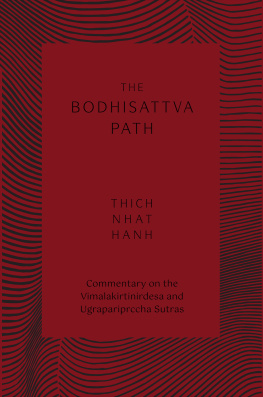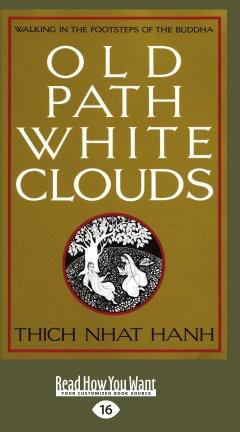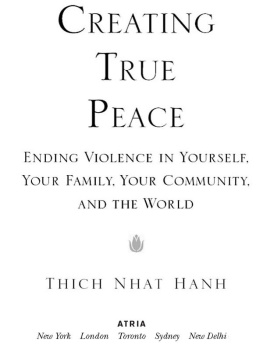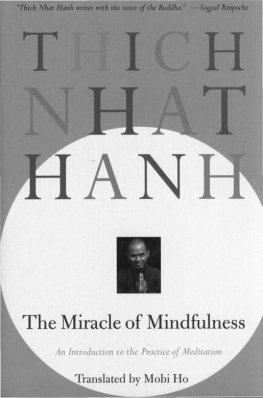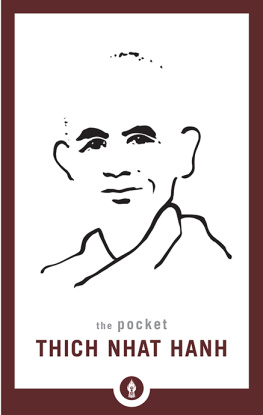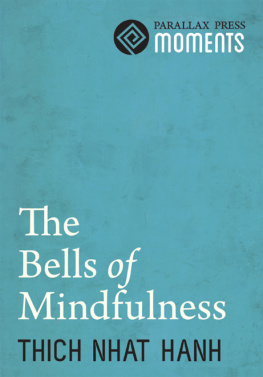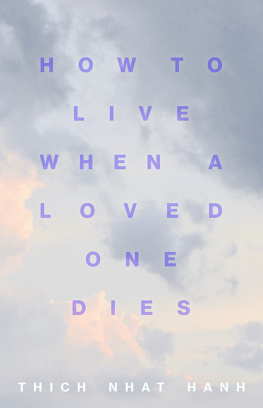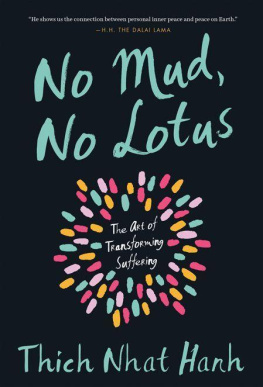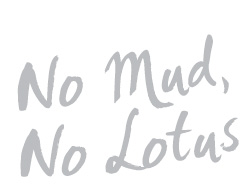
The Art of Transforming Suffering


Most people are afraid of suffering. But suffering is a kind of mud to help the lotus flower of happiness grow.
There can be no lotus flower without the mud.
THICH NHAT HANH
Contents
W e all want to be happy and there are many books and teachers in the world that try to help people be happier. Yet we all continue to suffer.
Therefore, we may think that were doing it wrong. Somehow we are failing at happiness. That isnt true. Being able to enjoy happiness doesnt require that we have zero suffering. In fact, the art of happiness is also the art of suffering well. When we learn to acknowledge, embrace, and understand our suffering, we suffer much less. Not only that, but were also able to go further and transform our suffering into understanding, compassion, and joy for ourselves and for others.
One of the most difficult things for us to accept is that there is no realm where theres only happiness and theres no suffering. This doesnt mean that we should despair. Suffering can be transformed. As soon as we open our mouth to say suffering, we know that the opposite of suffering is already there as well. Where there is suffering, there is happiness.
According to the creation story in the biblical book of Genesis, God said, Let there be light. I like to imagine that light replied, saying, God, I have to wait for my twin brother, darkness, to be with me. I cant be there without the darkness. God asked, Why do you need to wait? Darkness is there. Light answered, In that case, then I am also already there.
If we focus exclusively on pursuing happiness, we may regard suffering as something to be ignored or resisted. We think of it as something that gets in the way of happiness. But the art of happiness is also and at the same time the art of knowing how to suffer well. If we know how to use our suffering, we can transform it and suffer much less. Knowing how to suffer well is essential to realizing true happiness.
SUFFERING AND HAPPINESS ARE NOT SEPARATE
When we suffer, we tend to think that suffering is all there is at that moment, and happiness belongs to some other time or place. People often ask, Why do I have to suffer? Thinking we should be able to have a life without any suffering is as deluded as thinking we should be able to have a left side without a right side. The same is true of thinking we have a life in which no happiness whatsoever is to be found. If the left says, Right, you have to go away. I dont want you. I only want the leftthats nonsense, because then the left would have to stop existing as well. If theres no right, then theres no left. Where there is no suffering, there can be no happiness either, and vice versa.
If we can learn to see and skillfully engage with both the presence of happiness and the presence of suffering, we will go in the direction of enjoying life more. Every day we go a little farther in that direction, and eventually we realize that suffering and happiness are not two separate things.
Cold air can be painful if you arent wearing enough warm clothes. But when youre feeling overheated or youre walking outside with proper clothing, the bracing sensation of cold air can be a source of feeling joy and aliveness. Suffering isnt some kind of external, objective source of oppression and pain. There might be things that cause you to suffer, such as loud music or bright lights, which may bring other people joy. There are things that bring you joy that annoy other people. The rainy day that ruins your plans for a picnic is a boon for the farmer whose field is parched.
Happiness is possible right now, todaybut happiness cannot be without suffering. Some people think that in order to be happy they must avoid all suffering, and so they are constantly vigilant, constantly worrying. They end up sacrificing all their spontaneity, freedom, and joy. This isnt correct. If you can recognize and accept your pain without running away from it, you will discover that although pain is there, joy can also be there at the same time.
Some say that suffering is only an illusion or that to live wisely we have to transcend both suffering and joy. I say the opposite. The way to suffer well and be happy is to stay in touch with what is actually going on; in doing so, you will gain liberating insights into the true nature of suffering and of joy.
NO MUD, NO LOTUS
Both suffering and happiness are of an organic nature, which means they are both transitory; they are always changing. The flower, when it wilts, becomes the compost. The compost can help grow a flower again. Happiness is also organic and impermanent by nature. It can become suffering and suffering can become happiness again.
If you look deeply into a flower, you see that a flower is made only of nonflower elements. In that flower there is a cloud. Of course we know a cloud isnt a flower, but without a cloud, a flower cant be. If theres no cloud, theres no rain, and no flower can grow. You dont have to be a dreamer to see a cloud floating in a flower. Its really there. Sunlight is also there. Sunlight isnt flower, but without sunlight no flower is possible.
If we continue to look deeply into the flower, we see many other things, like the earth and the minerals. Without them a flower cannot be. So its a fact that a flower is made only of nonflower elements. A flower cant be by herself alone. A flower can only inter-be with everything else. You cant remove the sunlight, the soil, or the cloud from the flower.
In each of our Plum Village practice centers around the world, we have a lotus pond. Everyone knows we need to have mud for lotuses to grow. The mud doesnt smell so good, but the lotus flower smells very good. If you dont have mud, the lotus wont manifest. You cant grow lotus flowers on marble. Without mud, there can be no lotus.
It is possible of course to get stuck in the mud of life. Its easy enough to notice mud all over you at times. The hardest thing to practice is not allowing yourself to be overwhelmed by despair. When youre overwhelmed by despair, all you can see is suffering everywhere you look. You feel as if the worst thing is happening to you. But we must remember that suffering is a kind of mud that we need in order to generate joy and happiness. Without suffering, theres no happiness. So we shouldnt discriminate against the mud. We have to learn how to embrace and cradle our own suffering and the suffering of the world, with a lot of tenderness.
When I lived in Vietnam during the war, it was difficult to see our way through that dark and heavy mud. It seemed like the destruction would just go on and on forever. Every day people would ask me if I thought the war would end soon. It was very difficult to answer, because there was no end in sight. But I knew if I said, I dont know, that would only water their seeds of despair. So when people asked me that question, I replied, Everything is impermanent, even war. It will end some day. Knowing that, we could continue to work for peace. And indeed the war did end. Now the former mortal enemies are busily trading and touring back and forth, and people throughout the world enjoy practicing our traditions teachings on mindfulness and peace.
Next page

